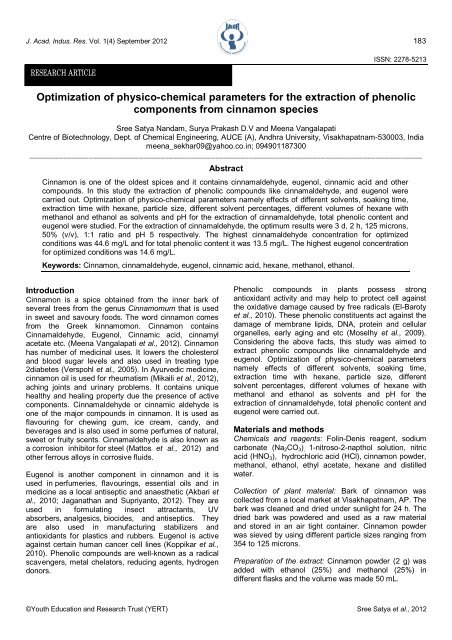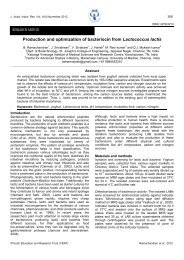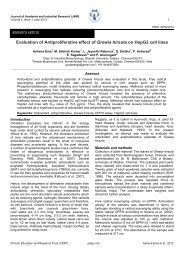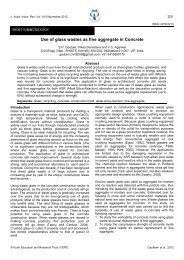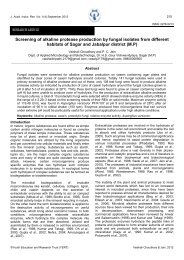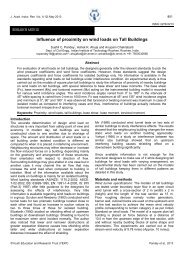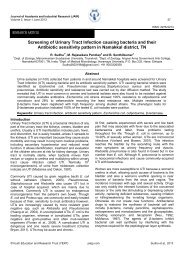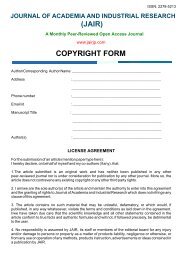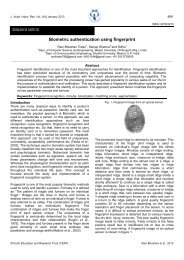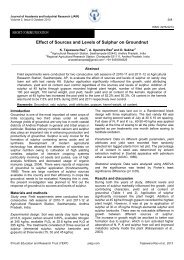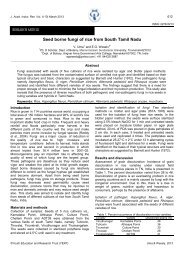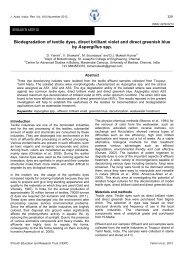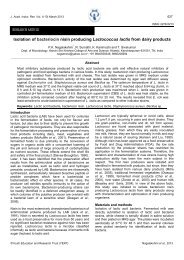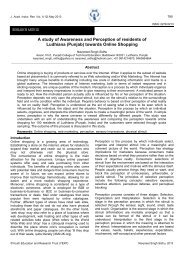Optimization of physico-chemical parameters for the extraction of ...
Optimization of physico-chemical parameters for the extraction of ...
Optimization of physico-chemical parameters for the extraction of ...
You also want an ePaper? Increase the reach of your titles
YUMPU automatically turns print PDFs into web optimized ePapers that Google loves.
J. Acad. Indus. Res. Vol. 1(4) September 2012 183RESEARCH ARTICLEISSN: 2278-5213<strong>Optimization</strong> <strong>of</strong> <strong>physico</strong>-<strong>chemical</strong> <strong>parameters</strong> <strong>for</strong> <strong>the</strong> <strong>extraction</strong> <strong>of</strong> phenoliccomponents from cinnamon speciesSree Satya Nandam, Surya Prakash D.V and Meena VangalapatiCentre <strong>of</strong> Biotechnology, Dept. <strong>of</strong> Chemical Engineering, AUCE (A), Andhra University, Visakhapatnam-530003, Indiameena_sekhar09@yahoo.co.in; 094901187300_____________________________________________________________________________________________AbstractCinnamon is one <strong>of</strong> <strong>the</strong> oldest spices and it contains cinnamaldehyde, eugenol, cinnamic acid and o<strong>the</strong>rcompounds. In this study <strong>the</strong> <strong>extraction</strong> <strong>of</strong> phenolic compounds like cinnamaldehyde, and eugenol werecarried out. <strong>Optimization</strong> <strong>of</strong> <strong>physico</strong>-<strong>chemical</strong> <strong>parameters</strong> namely effects <strong>of</strong> different solvents, soaking time,<strong>extraction</strong> time with hexane, particle size, different solvent percentages, different volumes <strong>of</strong> hexane withmethanol and ethanol as solvents and pH <strong>for</strong> <strong>the</strong> <strong>extraction</strong> <strong>of</strong> cinnamaldehyde, total phenolic content andeugenol were studied. For <strong>the</strong> <strong>extraction</strong> <strong>of</strong> cinnamaldehyde, <strong>the</strong> optimum results were 3 d, 2 h, 125 microns,50% (v/v), 1:1 ratio and pH 5 respectively. The highest cinnamaldehyde concentration <strong>for</strong> optimizedconditions was 44.6 mg/L and <strong>for</strong> total phenolic content it was 13.5 mg/L. The highest eugenol concentration<strong>for</strong> optimized conditions was 14.6 mg/L.Keywords: Cinnamon, cinnamaldehyde, eugenol, cinnamic acid, hexane, methanol, ethanol.IntroductionCinnamon is a spice obtained from <strong>the</strong> inner bark <strong>of</strong>several trees from <strong>the</strong> genus Cinnamomum that is usedin sweet and savoury foods. The word cinnamon comesfrom <strong>the</strong> Greek kinnamomon. Cinnamon containsCinnamaldehyde, Eugenol, Cinnamic acid, cinnamylacetate etc. (Meena Vangalapati et al., 2012). Cinnamonhas number <strong>of</strong> medicinal uses. It lowers <strong>the</strong> cholesteroland blood sugar levels and also used in treating type2diabetes (Verspohl et al., 2005). In Ayurvedic medicine,cinnamon oil is used <strong>for</strong> rheumatism (Mikaili et al., 2012),aching joints and urinary problems. It contains uniquehealthy and healing property due <strong>the</strong> presence <strong>of</strong> activecomponents. Cinnamaldehyde or cinnamic aldehyde isone <strong>of</strong> <strong>the</strong> major compounds in cinnamon. It is used asflavouring <strong>for</strong> chewing gum, ice cream, candy, andbeverages and is also used in some perfumes <strong>of</strong> natural,sweet or fruity scents. Cinnamaldehyde is also known asa corrosion inhibitor <strong>for</strong> steel (Mattos et al., 2012) ando<strong>the</strong>r ferrous alloys in corrosive fluids.Eugenol is ano<strong>the</strong>r component in cinnamon and it isused in perfumeries, flavourings, essential oils and inmedicine as a local antiseptic and anaes<strong>the</strong>tic (Akbari etal., 2010; Jaganathan and Supriyanto, 2012). They areused in <strong>for</strong>mulating insect attractants, UVabsorbers, analgesics, biocides, and antiseptics. Theyare also used in manufacturing stabilizers andantioxidants <strong>for</strong> plastics and rubbers. Eugenol is activeagainst certain human cancer cell lines (Koppikar et al.,2010). Phenolic compounds are well-known as a radicalscavengers, metal chelators, reducing agents, hydrogendonors.Phenolic compounds in plants possess strongantioxidant activity and may help to protect cell against<strong>the</strong> oxidative damage caused by free radicals (El-Barotyet al., 2010). These phenolic constituents act against <strong>the</strong>damage <strong>of</strong> membrane lipids, DNA, protein and cellularorganelles, early aging and etc (Moselhy et al., 2009).Considering <strong>the</strong> above facts, this study was aimed toextract phenolic compounds like cinnamaldehyde andeugenol. <strong>Optimization</strong> <strong>of</strong> <strong>physico</strong>-<strong>chemical</strong> <strong>parameters</strong>namely effects <strong>of</strong> different solvents, soaking time,<strong>extraction</strong> time with hexane, particle size, differentsolvent percentages, different volumes <strong>of</strong> hexane withmethanol and ethanol as solvents and pH <strong>for</strong> <strong>the</strong><strong>extraction</strong> <strong>of</strong> cinnamaldehyde, total phenolic content andeugenol were carried out.Materials and methodsChemicals and reagents: Folin-Denis reagent, sodiumcarbonate (Na 2 CO 3 ) , 1-nitroso-2-napthol solution, nitricacid (HNO 3 ), hydrochloric acid (HCl), cinnamon powder,methanol, ethanol, ethyl acetate, hexane and distilledwater.Collection <strong>of</strong> plant material: Bark <strong>of</strong> cinnamon wascollected from a local market at Visakhapatnam, AP. Thebark was cleaned and dried under sunlight <strong>for</strong> 24 h. Thedried bark was powdered and used as a raw materialand stored in an air tight container. Cinnamon powderwas sieved by using different particle sizes ranging from354 to 125 microns.Preparation <strong>of</strong> <strong>the</strong> extract: Cinnamon powder (2 g) wasadded with ethanol (25%) and methanol (25%) indifferent flasks and <strong>the</strong> volume was made 50 mL.©Youth Education and Research Trust (YERT) Sree Satya et al., 2012
J. Acad. Indus. Res. Vol. 1(4) September 2012 184The solution was soaked <strong>for</strong> 1 d and 3 d respectively.After <strong>the</strong> soaking time, <strong>the</strong> solution was filtered usingWhatman No.1 filter paper and <strong>the</strong> filtrate solution washeated to 78C and 65C and made up to 50 mL withdistilled water and hexane and incubated <strong>for</strong> 2 h.Estimation <strong>of</strong> <strong>the</strong> compounds: Total phenolic content andcinnamaldehyde was estimated according to <strong>the</strong> method<strong>of</strong> Folin-Denis (Schanderl, 1970). Eugenol was estimatedaccording to <strong>the</strong> method <strong>of</strong> (Olcay, 1968).Results and discussionDifferent organic solvents such as methanol, ethanol,ethyl acetate and water were used to extract <strong>the</strong>optimum yield <strong>of</strong> cinnamaldehyde, total phenolic contentand eugenol from cinnamon species. Forcinnamaldehyde and total phenolic content, methanolshowed best results and <strong>the</strong> concentrations were 23.625mg/L, 9 mg/L respectively. For eugenol, ethanol showedbest results and its concentration was 12.4 mg/L (Fig. 1).The samples were incubated under proper conditions atdifferent time intervals viz., 1, 2, 3 and 4 d to investigate<strong>the</strong> influence on <strong>extraction</strong> <strong>of</strong> cinnamaldehyde and totalphenolic content and eugenol. It was observed that 3 rdwas <strong>the</strong> best soaking time <strong>for</strong> <strong>the</strong> <strong>extraction</strong> <strong>of</strong>cinnamaldehyde and total phenolic content and <strong>the</strong>concentrations were 30.2 mg/L, 10.8 mg/L. Second daywas suitable <strong>for</strong> <strong>the</strong> <strong>extraction</strong> <strong>of</strong> eugenol and itsconcentration was 12.5 mg/L (Fig. 2).To investigate <strong>the</strong> influence <strong>of</strong> hexane on <strong>extraction</strong> <strong>of</strong>cinnamaldehyde, total phenolic content and eugenoldifferent time intervals were taken viz., 1, 2, 3 and 4 h.Solvent-Solvent <strong>extraction</strong> was done with hexane as one<strong>of</strong> <strong>the</strong> solvent. The optimum concentrations wereobserved at 2 nd h and concentrations were 30.4 mg/L,10.9 mg/L and 12.6 mg/L respectively (Fig. 3). Differentparticle size viz., 354, 328, 250, 205, 149, 125 and 74microns were used to find out <strong>the</strong> optimumconcentrations <strong>of</strong> cinnamaldehyde, total phenolic contentand eugenol. The present investigation suggests that <strong>the</strong><strong>extraction</strong> <strong>of</strong> cinnamaldehyde, total phenolic content andeugenol at different particle sizes indicates that <strong>the</strong>optimum particle size was 125 microns <strong>for</strong> <strong>extraction</strong> <strong>of</strong>cinnamaldehyde, total phenolic content and eugenol. Theoptimum concentrations were 30.5 mg/L, 11 mg/L and12.8 mg/L (Fig. 4). Percentage <strong>of</strong> <strong>the</strong> solvent plays a vitalrole <strong>for</strong> <strong>the</strong> <strong>extraction</strong> <strong>of</strong> components. Different solvent(methanol and ethanol) percentages namely 0%, 20%,40%, 50%, 60%, 80% and 100% showed significantvariations. Figure 4 showed that optimum solventpercentages were at 50% methanol <strong>for</strong> bothcinnamaldehyde and total phenolic content and 80%ethanol <strong>for</strong> eugenol and <strong>the</strong> concentrations were 31mg/L, 11.2 mg/L and 13.5 mg/L respectively. Theobserved results <strong>for</strong> eugenol were found to becoincidence with <strong>the</strong> results obtained by Kamaliroosta etal. (2012) <strong>for</strong> cinnamaldehyde. The total phenolic contentresults coincide with <strong>the</strong> findings <strong>of</strong> Kubo et al. (1996)(Fig. 5).CA, TPC and Eugenol (mg/L)CA, TPC and Eugenol (mg/L)CA, TPC and Eugenol (mg/L)CA, TPC and Eugenol (mg/L)Fig. 1. Effect <strong>of</strong> different solvents <strong>for</strong> <strong>the</strong> <strong>extraction</strong> <strong>of</strong>phenolic components.Fig. 2. Effect <strong>of</strong> soaking time <strong>for</strong> <strong>the</strong> <strong>extraction</strong> <strong>of</strong>phenolic components.Soaking time (day)Fig. 3. Effect <strong>of</strong> <strong>extraction</strong> time with hexane <strong>for</strong> <strong>the</strong><strong>extraction</strong> <strong>of</strong> phenolic components.Extraction time (h)Fig. 4. Effect <strong>of</strong> different particle size <strong>for</strong> <strong>the</strong> <strong>extraction</strong> <strong>of</strong>phenolic components.Particle size (micron)©Youth Education and Research Trust (YERT) Sree Satya et al., 2012
J. Acad. Indus. Res. Vol. 1(4) September 2012 185To determine <strong>the</strong> volume <strong>of</strong> hexane <strong>for</strong> <strong>the</strong> <strong>extraction</strong> <strong>of</strong>cinnamaldehyde, total phenolic content and eugenol,different volumes <strong>of</strong> hexane with solvent (methanol andethanol) were made in <strong>the</strong> ratio 2:1, 1:1, 1:2 and 1:3.These different volumes and solvents (methanol andethanol) showed a significant effect on <strong>the</strong> <strong>extraction</strong>.The optimum <strong>extraction</strong> <strong>of</strong> cinnamaldehyde and totalphenolic content were achieved at 1:1 with methanol.The optimum concentrations were 32.5 mg/L, 11.8 mg/L.For eugenol, <strong>the</strong> optimum <strong>extraction</strong> was recorded at 1:1with ethanol and <strong>the</strong> concentration was 14.2 mg/L(Fig. 6). The findings <strong>of</strong> <strong>the</strong> study are in corroborationwith <strong>the</strong> report by Gulab et al. (2005). To determine <strong>the</strong>effect <strong>of</strong> pH on <strong>the</strong> <strong>extraction</strong> process, different pHvalues namely 5, 6, 7, 8, and 9 were used. It wasobserved that <strong>the</strong> <strong>extraction</strong> <strong>of</strong> cinnamaldehyde, totalphenolic content were found to be optimum at pH 8.0and optimum concentrations were 42.5 mg/L, 13.5 mg/L.The optimum pH <strong>for</strong> eugenol was 5 at an optimumconcentration <strong>of</strong> 14.6 mg/L (Fig. 7). The observed resultswere in accordance with <strong>the</strong> findings <strong>of</strong> Mattos et al.(2012) and Baseri et al. (2009).ConclusionIn this study <strong>the</strong> <strong>extraction</strong> <strong>of</strong> phenolic compounds likecinnamaldehyde, and eugenol were carried out.<strong>Optimization</strong> <strong>of</strong> <strong>physico</strong>-<strong>chemical</strong> <strong>parameters</strong> namelyeffects <strong>of</strong> different solvents, soaking time, <strong>extraction</strong> timewith hexane, particle size, different solvent percentages,different volumes <strong>of</strong> hexane with methanol and ethanolas solvents and pH <strong>for</strong> <strong>the</strong> <strong>extraction</strong> <strong>of</strong> cinnamaldehyde,total phenolic content and eugenol were studied. For <strong>the</strong><strong>extraction</strong> <strong>of</strong> cinnamaldehyde, <strong>the</strong> optimum results were3 d, 2 h, 125 microns, 50% (v/v), 1:1 ratio and pH 5respectively. The highest cinnamaldehyde concentration<strong>for</strong> optimized conditions was 44.6 mg/L and <strong>for</strong> totalphenolic content it was 13.5 mg/L. The highest eugenolconcentration <strong>for</strong> optimized conditions was 14.6 mg/L.References1. Akbari, S., Mohammad Khoshnod, J., Rajaian, H. andAfsharnasab, M. 2010. The use <strong>of</strong> eugenol as an anes<strong>the</strong>tic intransportation <strong>of</strong> with Indian shrimp (Fenneropenaeus indicus)post larvae. Turk. J. Fisheries Aquatic Sci. 10: 423-429.2. Baseri, H., Haghighi-Asl, A. and Mohmmad Lotfollahi, N. 2009.Effects <strong>of</strong> operating <strong>parameters</strong> on <strong>the</strong> cinnamaldehyde content<strong>of</strong> extracted essential oil using various methods. Chem. Engg.Technol. 33(2): 267-274.3. El-Baroty, G.S., Abd El-Baky, H.H., Farag, R.S. and Saleh,M.A. 2010. Characterzation <strong>of</strong> antioxidant and antimicrobialcompounds <strong>of</strong> cinnamon and ginger essential oils. Afri. J.Biochem. Res. 4(6): 167-174.4. Gulab Jham, N., Onkar Dhingra, D., Carolina Jardim, M. andValente, M.M. 2005. Identification <strong>of</strong> <strong>the</strong> major fungitoxiccomponent <strong>of</strong> cinnamon bark oil. Fitopatologia Brasileira. 30:404-408.5. Jaganathan, S.K. and Supriyanto, E. 2012. Antiproliferativeand molecular mechanism <strong>of</strong> eugenol-induced apoptosis incancer cells. Mol. 17: 6290-6304.6. Kamaliroosta, L., Gharachorloo, M., Kamaliroosta, Z. AndAlimohammad Zadeh, K. 2012. Extraction <strong>of</strong> cinnamonessential oil and identification <strong>of</strong> its <strong>chemical</strong> compounds. J.Med. Plants Res. 6(4): 609-614.CA, TPC and Eugenol (mg/L)CA, TPC and Eugenol (mg/L)Fig. 5. Effect <strong>of</strong> solvent percentages <strong>for</strong> <strong>the</strong> <strong>extraction</strong> <strong>of</strong>phenolic components.Solvent percentageFig. 6. Effect <strong>of</strong> different volumes <strong>of</strong> hexane with solvents<strong>for</strong> <strong>the</strong> <strong>extraction</strong> <strong>of</strong> phenolic components.2:1 1:1 1:2 1:3Ratio <strong>of</strong> hexane with solvents7. Koppikar, J., Amit Choudari, S., Snehal Suryavashi, A., ShwetaKumari, Chattopadhyay, S. and Kaul-Ghanekar, R. 2010.Aqeous cinnamon extract (ACE-c) from <strong>the</strong> bark <strong>of</strong>Cinnamomum cassia causes apoptosis in human cervicalcancer cell line (SiHa) through loss <strong>of</strong> mitochondrial membranepotential. BMC Cancer. 10: 210.8. Kubo, M., Ma, S., Wu, J. and Matsuda, H. 1996.Antiinflammatory activities <strong>of</strong> 70% methanolic extract <strong>of</strong>cinnamomi cortex. Biol. Pharm. Bull. 19: 1041-1045.9. Mattos, D., Danilo Florisvaldo, B., Josianne Arantes Do, N.,Nadia Nara, B. and Roberta, H. 2012. Cinnamon essential oiland cinnamaldehyde in <strong>the</strong> control <strong>of</strong> bacterial bi<strong>of</strong>ilms <strong>for</strong>medon stainless steel surfaces. Eur. Food Res. Technol. 234: 821-832.10. Meena, V., Sree Satya, N., Surya Prakash, DV. and Sumanjali,A. 2012. A review on pharmacological activities and clinicaleffects <strong>of</strong> cinnamon species. Res. J. Pharm. Biol. Chem. Sci.3(1): 653-663.11. Mikaili, P., Shayegh, J., Sarahroodi, S. and Sharifi, M. 2012.Pharmacological properties <strong>of</strong> herbal oil extracts used inIranian traditional medicine. Adv. Environ. Biol. 6(1): 153-158.12. Moselhy, S. and Husein Ali, K.H. 2009. Hepato protectiveeffect <strong>of</strong> cinnamon extracts against carbon tetrachlorideinduced oxidative stress and liver injury in rats. Biol. Res. 42:93-98.13. Olcay, A. 1968. Spectrophotometric determination <strong>of</strong>eugenol. La Revue “Communications de la Faculté desSciences de l’Universite D’Ankara. pp.85-91.14. Schanderl, S.H. 1970. In: Method in food analysis academicpress, New York. p.709.15. Verspohl, E., Katrin Bauer, J. and Neddermann, E. 2005.Antidiabetic effect <strong>of</strong> Cinnamomum cassia and Cinnamomumzeylanicum in vivo and in vitro. Phyto<strong>the</strong>r. Res. 19(3): 203-206.©Youth Education and Research Trust (YERT) Sree Satya et al., 2012


